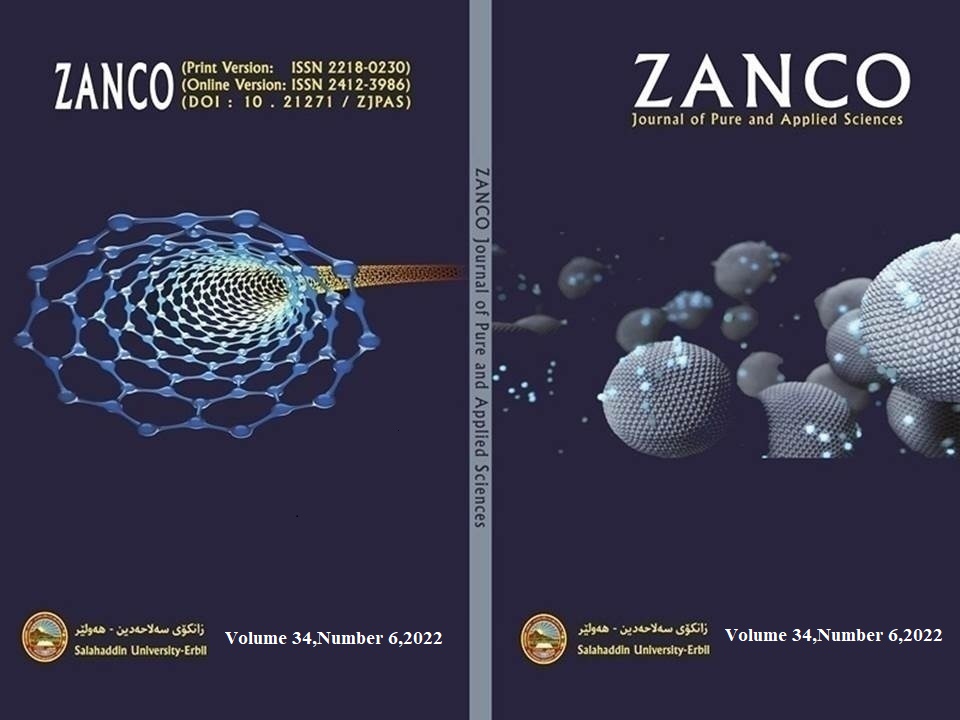Epidemicity and Genotyping of Pediculus humanus capitis de Geer by Cytochrome Oxidase I gene among Syrian refugees dwelling some camps of Erbil, Kurdistan Region of Iraq
DOI:
https://doi.org/10.21271/ZJPAS.34.6.20Keywords:
Pediculus capitis, Syrian refugees, epidemiology, molecular identification, ErbilAbstract
The objectives of the current study are to determine risk factors associated with the rampancy and molecular genotyping of the head lice (Pediculus humanus capitis de Geer) infesting Syrian refugees in some temporary camps of Erbil, Kurdistan region of Iraq. To meet the requirements of the study, some primary schools of refugee camps were chosen to collect the relevant data in the afore-mentioned city. The V-Comb trap method was used to obtain specimens of head lice from 202 students of both gender who attend refugee camp schools regularly. The analyzed data revealed that the prevalence rates of pediculosis among 6-10 and 11-15-year-old students were 69% and 64% respectively. The highest infestation rate (79%) was recorded among female students, whilst the lowest outbreak rate (61%) was detected among male students. Regarding the impact of hair lengths on the prevalence of the insect, the highest rate of infection (81.53%) was recorded for medium hair whilst the lowest rate (41.17%) was determined for long hairs. Concerning the hair posture factor, the rates of infestation were 100%, 73% and 55% for spring, straight, and wavy hairs respectively in the 6-10-year-old group. Ultimately, Genomic DNA extraction were performed and Mitochondrion Cytochrome Oxidase I gene was used successfully for PCR amplification and sanger sequencing for genotyping then submission of our query sequences to the NCBI GenBank .
References
AL-SHAWA, R. M. 2006. Head louse infestations in Gaza governorates. Journal of medical entomology, 43, 505-507.
AMIRKHANI, M., ALAVIAN, S., MAESOUMI, H., AMINAIE, T., DASHTI, M., ARDALAN, G., ZIAODDINI, H., MIRMOGHTADAEE, P., POURSAFA, P. & KELISHADI, R. 2011. A nationwide survey of prevalence of pediculosis in children and adolescents in Iran. Iranian Red Crescent Medical Journal, 13, 167.
ASHFAQ, M., PROSSER, S., NASIR, S., MASOOD, M., RATNASINGHAM, S. & HEBERT, P. D. 2015. High diversity and rapid diversification in the head louse, Pediculus humanus (Pediculidae: Phthiraptera). Scientific Reports, 5, 1-13.
ATAMBAY, M., KARAMAN, O., KARAMAN, U., AYCAN, O., YOLOĞLU, S. & DALDAL, N. 2007. The frequency of intestinal parasites and head lice among students of the Akşemsettin Primary School for Deaf Students. Turkiye Parazitolojii Dergisi, 31, 62-65.
BAHAMDAN, K., MAHFOUZ, A. A., TALLAB, T., BADAWI, I. A. & AL‐AMARI, O. M. 1996. Skin diseases among adolescent boys in Abha, Saudi Arabia. International journal of dermatology, 35, 405-407.
BONILLA, D. L., DURDEN, L. A., EREMEEVA, M. E. & DASCH, G. A. 2013. The biology and taxonomy of head and body lice—implications for louse-borne disease prevention. PLoS Pathogens, 9, e1003724.
BORGES, R. & MENDES, J. 2002. Epidemiological aspects of head lice in children attending day care centres, urban and rural schools in Uberlandia, central Brazil. Memórias do Instituto Oswaldo Cruz, 97, 189-192.
CHUNGE, R. N. 1986. A study of head lice among primary schoolchildren in Kenya. Transactions of the Royal Society of Tropical Medicine and Hygiene, 80, 42-46.
FALAGAS, M. E., MATTHAIOU, D. K., RAFAILIDIS, P. I., PANOS, G. & PAPPAS, G. 2008. Worldwide prevalence of head lice. Emerging infectious diseases, 14, 1493-1494.
LESSHAFFT, H., BAIER, A., GUERRA, H., TERASHIMA, A. & FELDMEIER, H. 2013. Prevalence and risk factors associated with pediculosis capitis in an impoverished urban community in Lima, Peru. Journal of Global Infectious Diseases, 5, 138.
MOHAMMED, A. 2012. Head lice infestation in schoolchildren and related factors in Mafraq governorate, Jordan. International Journal of Dermatology, 51, 168-172.
NAZARI, M., FAKOORZIBA, M. R. & SHOBEIRI, F. 2006. Pediculus capitis infestation according to sex and social factors in Hamedan, Iran. The Southeast Asian journal of tropical medicine and public health, 37, 95-98.
NEJATI, J., KEYHANI, A., KARESHK, A. T., MAHMOUDVAND, H., SAGHAFIPOUR, A., KHORAMINASAB, M., OLIAEE, R. T. & MOUSAVI, S. M. 2018. Prevalence and risk factors of pediculosis in primary school children in South West of Iran. Iranian journal of public health, 47, 1923.
TOHIT, N. F. M., RAMPAL, L. & MUN-SANN, L. 2017. Prevalence and predictors of pediculosis capitis among primary school children in Hulu Langat, Selangor. Med J Malaysia, 72, 12-7.
VAHABI, A., SHEMSHAD, K., SAYYADI, M., BIGLARIAN, A., VAHABI, B., SAYYAD, S., SHEMSHAD, M. & RAFINEJAD, J. 2012. Prevalence and risk factors of Pediculus (humanus) capitis (Anoplura: Pediculidae), in primary schools in Sanandaj City, Kurdistan Province, Iran. Trop Biomed, 29, 207-11.
VERMA, P. & NAMDEO, C. 2015. Treatment of pediculosis capitis. Indian journal of dermatology, 60, 238.
WILLEMS, S., LAPEERE, H., HAEDENS, N., PASTEELS, I., NAEYAERT, J.-M. & DE MAESENEER, J. 2005. The importance of socio-economic status and individual characteristics on the prevalence of head lice in schoolchildren. European Journal of Dermatology, 15, 387-392.
ZIAODDINI, A., RIAHI, R., HEIDARI-BENI, M., ZIAODDINI, H. & ZAMANI, S. 2019. National and Provincial Prevalence of Pediculus humanus capitis de Geer among Urban Students in Iran from 2014 to 2018. Journal of Research in Health Sciences, 19, e00459.
Downloads
Published
How to Cite
Issue
Section
License
Copyright (c) 2023 Hemdad H. Mawlood

This work is licensed under a Creative Commons Attribution 4.0 International License.














